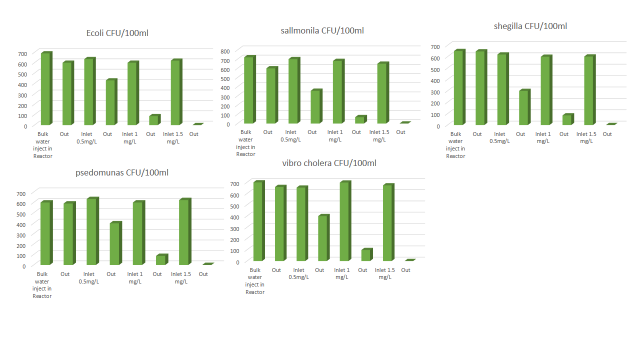The Evaluating Chlorine Dosage for Effective Disinfection and Antimicrobial Resistance Profiling in Drinking Water Under Climate Change Influences
Keywords:
Chlorination, biofilm annular reactor (BAR), Disease-Causing Microorganisms, Antimicrobial Resistance (AMR), Drinking Water, Climate ChangeAbstract
Introduction/Importance of Study: Climate patterns, such as heavy rainfall and flooding, can introduce contaminants into water sources, leading to increased microbial loads. Chlorine disinfection is essential in mitigating these risks by effectively destroying pathogens.
Novelty Statement: This study investigates the effectiveness of different chlorine disinfectant dosages in eliminating disease-causing microorganisms and assessing antimicrobial resistance (AMR) in drinking water.
Material and Method: A biofilm annular reactor (BAR) setup was utilized to assess the impact of chlorination on pathogenic microorganisms. Three chlorine doses were tested: 0.5 mg/L, 1 mg/L, and 1.5 mg/L. Samples were collected and analyzed for AMR. Five selective bacterial strains were isolated using the membrane filtration method, and antibiotic sensitivity was evaluated using the standardized Kirby-Bauer disc diffusion test.
Result and Discussion: The study isolated five gram-negative bacteria on selective agar: E. coli, Salmonella, Shigella, Pseudomonas, and Vibrio cholerae. Their antimicrobial resistance to five antibiotics (amoxicillin, AML 5 µg; ampicillin, AMP 10 µg; Azithromycin, AZM 15 µg; ceftriaxone, CRO 30 µg; and imipenem, IPM 10 µg) was tested on Mueller-Hinton (MH) media. Azithromycin demonstrated the highest activity against all isolates. The optimal chlorine concentration for removing these bacteria from water was 1.5 mg/L, due to chlorine’s high reactivity.
Concluding Remarks: The study concludes that a chlorine concentration of 1.5 mg/L is optimal for pathogen removal from water, and Azithromycin exhibited exceptional effectiveness against all resistant gram-negative bacterial isolates.
References
K. Guo, Z. Wu, C. Chen, and J. Fang, “UV/Chlorine Process: An Efficient Advanced Oxidation Process with Multiple Radicals and Functions in Water Treatment,” Acc. Chem. Res., vol. 55, no. 3, pp. 286–297, Feb. 2022, doi: 10.1021/ACS.ACCOUNTS.1C00269.
L. E. Anderson et al., “A review of long-term change in surface water natural organic matter concentration in the northern hemisphere and the implications for drinking water treatment,” Sci. Total Environ., vol. 858, no. Pt 1, Feb. 2023, doi: 10.1016/J.SCITOTENV.2022.159699.
S. Kataki, S. Chatterjee, M. G. Vairale, S. Sharma, and S. K. Dwivedi, “Concerns and strategies for wastewater treatment during COVID-19 pandemic to stop plausible transmission,” Resour. Conserv. Recycl., vol. 164, p. 105156, Jan. 2021, doi: 10.1016/J.RESCONREC.2020.105156.
E. Y. Y. Chan et al., “Narrative Review of Primary Preventive Interventions against Water-Borne Diseases: Scientific Evidence of Health-EDRM in Contexts with Inadequate Safe Drinking Water,” Int. J. Environ. Res. Public Health, vol. 18, no. 23, Dec. 2021, doi: 10.3390/IJERPH182312268.
“FAQs: Microbial Contamination | Mass.gov.” Accessed: Jul. 01, 2024. [Online]. Available: https://www.mass.gov/info-details/faqs-microbial-contamination
W. M. Manetu and A. M. Karanja, “Waterborne Disease Risk Factors and Intervention Practices: A Review,” OALib, vol. 08, no. 05, pp. 1–11, 2021, doi: 10.4236/OALIB.1107401.
R. Wang, M. Ji, H. Zhai, Y. Guo, and Y. Liu, “Occurrence of antibiotics and antibiotic resistance genes in WWTP effluent-receiving water bodies and reclaimed wastewater treatment plants,” Sci. Total Environ., vol. 796, p. 148919, Nov. 2021, doi: 10.1016/J.SCITOTENV.2021.148919.
S. Cheng et al., “Developing a restricted chlorine-dosing strategy for UV/chlorine and post-chlorination under different pH and UV irradiation wavelength conditions,” Chemosphere, vol. 258, p. 127393, Nov. 2020, doi: 10.1016/J.CHEMOSPHERE.2020.127393.
X. Zhang, P. Ren, J. Zhou, J. Li, Z. Li, and D. Wang, “Formation of disinfection byproducts in an ammonia-polluted source water with UV/chlorine treatment followed by post-chlorination: A pilot-scale study,” Environ. Technol. Innov., vol. 26, p. 102266, May 2022, doi: 10.1016/J.ETI.2021.102266.
D. L. Wu et al., “Contamination profile of antibiotic resistance genes in ground water in comparison with surface water,” Sci. Total Environ., vol. 715, May 2020, doi: 10.1016/J.SCITOTENV.2020.136975.
A. M. Voigt et al., “The investigation of antibiotic residues, antibiotic resistance genes and antibiotic-resistant organisms in a drinking water reservoir system in Germany,” Int. J. Hyg. Environ. Health, vol. 224, Mar. 2020, doi: 10.1016/J.IJHEH.2020.113449.
R. G. Skaland et al., “Impacts of climate change on drinking water quality in Norway,” J. Water Health, vol. 20, no. 3, pp. 539–550, Mar. 2022, doi: 10.2166/WH.2022.264.
Z. Zhu, C. Wu, D. Zhong, Y. Yuan, L. Shan, and J. Zhang, “Effects of pipe materials on chlorine-resistant biofilm formation under long-term high chlorine level,” Appl. Biochem. Biotechnol., vol. 173, no. 6, pp. 1564–1578, 2014, doi: 10.1007/S12010-014-0935-X.
S. Bhatti et al., “The Identification of Selective Pathogenic Microbial Community Biofilms in Different Distribution Pipeline Materials and Their Disinfection Kinetics,” Water (Switzerland), vol. 15, no. 23, p. 4099, Dec. 2023, doi: 10.3390/W15234099/S1.
J. Hyun-Jung, Y. J. Choi, and J. O. Ka, “Effects of diverse water pipe materials on bacterial communities and water quality in the annular reactor,” J. Microbiol. Biotechnol., vol. 21, no. 2, pp. 115–123, Feb. 2011, doi: 10.4014/JMB.1010.10012.
R. Cheswick, A. Nocker, G. Moore, B. Jefferson, and P. Jarvis, “Exploring the use of flow cytometry for understanding the efficacy of disinfection in chlorine contact tanks,” Water Res., vol. 217, Jun. 2022, doi: 10.1016/J.WATRES.2022.118420.
Jia,S.;Jia,R.;Zhang,K.;Sun,S.;Lu,N.;Wang,M.;Zhao,Q.Disinfection Characteristics of Pseudomonas Peli, a Chlorine-Resistant Bacterium Isolated from a Water Supply Network. Environ. Res. 2020, 185, 109417. [CrossRef]
Zhu, Z.; Wu, C.; Zhong, D.; Yuan, Y.; Shan, L.; Zhang, J. Effects of Pipe Materials on Chlorine-Resistant Biofilm Formation under Long-Term High Chlorine Level. Appl. Biochem. Biotechnol. 2014, 173, 1564–1578. [CrossRef] [PubMed]

Downloads
Published
How to Cite
Issue
Section
License
Copyright (c) 2024 50SEA

This work is licensed under a Creative Commons Attribution 4.0 International License.




















